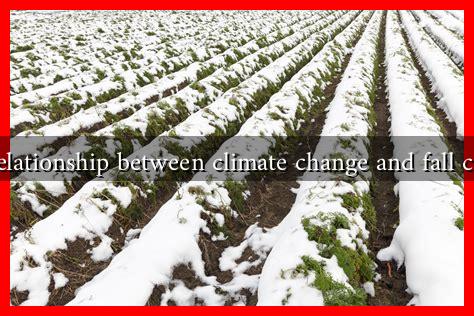-
Table of Contents
- What is the Relationship Between Climate Change and Fall Crop Diversity?
- The Impact of Climate Change on Agriculture
- Fall Crop Diversity: A Key to Resilience
- Case Studies: Successful Adaptation Strategies
- 1. The Midwest United States
- 2. The Netherlands
- Challenges to Fall Crop Diversity
- Conclusion: The Path Forward
What is the Relationship Between Climate Change and Fall Crop Diversity?
As the world grapples with the escalating impacts of climate change, the agricultural sector faces unprecedented challenges. Among these challenges is the relationship between climate change and crop diversity, particularly in the fall season. Understanding this relationship is crucial for ensuring food security and sustainable agricultural practices. This article delves into how climate change affects fall crop diversity, the implications for farmers, and potential strategies for adaptation.
The Impact of Climate Change on Agriculture
Climate change manifests through various phenomena, including rising temperatures, altered precipitation patterns, and increased frequency of extreme weather events. These changes have significant implications for agriculture, particularly for fall crops, which are typically planted in late summer and harvested in autumn. The following factors illustrate the impact of climate change on agriculture:
- Temperature Increases: Higher temperatures can lead to heat stress in crops, affecting their growth and yield.
- Altered Rainfall Patterns: Changes in precipitation can result in droughts or flooding, both of which can devastate fall crops.
- Pest and Disease Proliferation: Warmer temperatures can expand the range of pests and diseases, threatening crop health.
Fall Crop Diversity: A Key to Resilience
Crop diversity refers to the variety of crops grown in a particular area. In the context of fall crops, diversity can enhance resilience against climate change. Diverse cropping systems can mitigate risks associated with climate variability and improve overall ecosystem health. Here are some benefits of maintaining fall crop diversity:
- Risk Mitigation: Diverse crops can buffer against total crop failure due to pests, diseases, or adverse weather conditions.
- Soil Health Improvement: Different crops contribute to soil fertility and structure, reducing the need for chemical fertilizers.
- Enhanced Pollinator Support: A variety of crops can attract different pollinators, which are essential for many agricultural systems.
Case Studies: Successful Adaptation Strategies
Several regions have implemented successful strategies to enhance fall crop diversity in the face of climate change. These case studies provide valuable insights into adaptive practices:
1. The Midwest United States
Farmers in the Midwest have increasingly adopted cover cropping and crop rotation practices. By planting diverse cover crops in the fall, they improve soil health and reduce erosion. Research from the USDA Natural Resources Conservation Service indicates that these practices can lead to a 20% increase in soil organic matter, enhancing resilience against climate variability.
2. The Netherlands
The Dutch agricultural sector has embraced innovative practices such as intercropping and agroforestry. By growing multiple crops together, farmers can optimize land use and reduce dependency on single crops. This approach has been shown to increase yields by up to 30% while also improving biodiversity.
Challenges to Fall Crop Diversity
Despite the benefits of crop diversity, several challenges hinder its adoption:
- Market Pressures: Farmers often face economic pressures to grow monocultures that are more profitable in the short term.
- Lack of Knowledge: Many farmers may not be aware of the benefits of crop diversity or how to implement it effectively.
- Policy Barriers: Agricultural policies may favor large-scale monoculture farming, limiting support for diverse cropping systems.
Conclusion: The Path Forward
The relationship between climate change and fall crop diversity is complex but critical for sustainable agriculture. As climate change continues to pose challenges to food production, enhancing crop diversity emerges as a vital strategy for resilience. By adopting diverse cropping systems, farmers can mitigate risks, improve soil health, and support biodiversity. However, overcoming economic, educational, and policy barriers is essential for promoting these practices. As we move forward, collaboration among farmers, researchers, and policymakers will be crucial in fostering a more resilient agricultural landscape.
In summary, embracing fall crop diversity not only helps combat the adverse effects of climate change but also paves the way for a sustainable agricultural future. The time to act is now, as the health of our planet and food systems depends on it.

